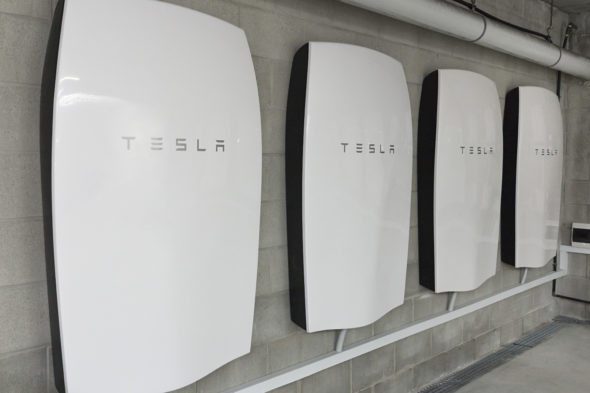A home on Queensland’s Gold Coast has installed what is believed to be the largest residential Tesla battery storage system in Australia – and one of the biggest in the world – with a total of six 6.4kWh lithium-ion Powerwall units hooked up to store the solar generation from a massive 24kW rooftop solar PV system.

The impressive home solar and storage system – the six Powerwalls (pictured above) have a combined capacity of 38.4kWh and the solar system generates 36,355kWh a year – was installed from scratch by Natural Solar, and will allow the home owner, Clayton Lyndon, and his family to store and use 98 per cent of the solar they generate.
Why? We asked Natural Solar’s managing director Chris Williams that very question. Here’s what he said…
“What we’re seeing here is typifying the greater consumer awareness and excitement around battery storage,” Williams told One Step Off The Grid in an interview on Friday.
“Customers are avoiding reliance on the grid and creating greater flexibility of when and how they use power. We’ve seen that translate into hundreds of (battery storage) installations around the country.
But excitement and grid independence aside, Williams reckons the return on investment for Lyndon’s system is actually looking pretty good.

“By scaling the system up, the price per kW is actually very attractive,” he said. “By consuming the entire production of solar system, he’s looking at anywhere between 5-6 years ROI.
“Total production a year is astronomical, so that’s obviously a huge production across the year; a very high quality system performing very efficiently.”
Williams says that since his company outed itself as one of the first certified reseller of Tesla Powerwall units last year, he has already seen a shift in consumer attitude to battery storage.
“When Natural Solar announced becoming a Tesla reseller we had an immediate uptake and large amount of volumes coming through,” he said. “But most customers wouldn’t go bigger than one battery, maybe two.
“Gradually, by around about the second quarter of this year, two batteries became very normal. Now, two and three and four batteries are a very common system.
“I firmly believe 2016 will be seen as a really pivotal year in the industry, with the move from solar alone to integrated home energy management systems,” he said.
Williams says the mix of people who are installing solar and storage from scratch, or who are adding storage to an existing PV system, or upgrading their solar and then adding storage, was pretty evenly distributed.
But Gold Coast customer, Lyndon, went straight for 6 power walls, he said – one system installed all at once, including three separate 8kW PV arrays on the roof and a bidirectional meter controlling the smarts. 
“It was a a bit of a feat of engineering by our team, but it only took three days.
More time was taken pre-installation, he said, with the home owner going through “a very long process” with one of Natural Solar’s engineers to ascertain what the most effective and attractive system would be for him.
As far as Williams is concerned, they got this part “spot on” – “a self-consumption of 98 per cent is perfect,” he said.
“The expectation is this customer will be able to save more than $13,000 per year on energy bills should he fully utilise all of the power generated from the panels, and that is stored within the Tesla Powerwalls,” he said in a statement.
Full Tesla Powerwall and solar panel solutions from Natural Solar start from $13,590.
This article was originally published on RE sister site One Step Off The Grid. To sign up for the weekly newsletter, click here.







